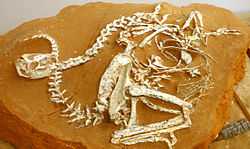Khaan
| Khaan Temporal range: Late Cretaceous, 84–75Ma | |
|---|---|
 | |
| Holotype IGM 100/1127 | |
| Scientific classification | |
| Kingdom: | Animalia |
| Phylum: | Chordata |
| Clade: | Dinosauria |
| Suborder: | Theropoda |
| Clade: | †Oviraptorosauria |
| Family: | †Oviraptoridae |
| Subfamily: | †Oviraptorinae |
| Genus: | †Khaan Clark, Norell & Barsbold, 2001 |
| Species: | † K. mckennai |
| Binomial name | |
| Khaan mckennai Clark, Norell, & Barsbold, 2001 | |
Khaan (/ˈkɑːn/; Mongol [χaːŋ] 'lord') was an oviraptorid dinosaur that was found in the Djadochta Formation of Mongolia and lived in the Late Cretaceous Period (Campanian), 75 million years ago.
Discovery


The type species Khaan mckennai was in 2001 named by James M. Clark e.a. The genus name is derived from Mongol khaan, "lord" or "ruler". The specific name honours the paleontologist Malcolm Carnegie McKenna.
The holotype IGM 100/1127, consists of an almost complete skeleton found together with another specimen, IGM 100/1002. Together they were informally referred to as "Romeo and Juliet". These individuals are about four feet long. A third, considerably larger, specimen, IGM 100/973, was referred to the species.
Description
Khaan did not differ much from other oviraptorids. At first, its remains were assigned to "Ingenia", but the Khaan manual structure, lacking the expansion of the upper third metacarpal, was considered to differ sufficiently from that of "Ingenia" for it to be assigned to its own genus.
The oviraptorid diet is disputed, with plants and molluscs having been suggested. Like other oviraptorids, Khaan was probably at least partially a meat eater, feeding on small vertebrates like mammals, lizards and possibly other small dinosaurs. It was also probably feathered.
Classification

Khaan was by Clark assigned to the Oviraptoridae. Among oviraptorids, it was probably more closely related to Conchoraptor.
The cladogram below follows an analysis by Fanti et al., 2012.[1]
| Oviraptoridae |
| |||||||||||||||||||||||||||||||||||||||||||||
| |
References
- ↑ Fanti F, Currie PJ, Badamgarav D (2012). "New Specimens of Nemegtomaia from the Baruungoyot and Nemegt Formations (Late Cretaceous) of Mongolia." PLoS ONE, 7(2): e31330. doi:10.1371/journal.pone.0031330
- Clark, J. M., Norell, M. A. & Barsbold R. (2001) Two new oviraptorids (Theropoda:Oviraptorosauria), upper Cretaceous Djadokhta Formation, Ukhaa Tolgod, Mongolia. Journal of Vertebrate Paleontology 21(2): 209-213